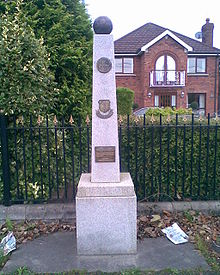Glenmalure Park
| Milltown | |
 |
|
| Location | Milltown Road, Milltown, Dublin 6, Ireland |
|---|---|
| Owner | Jesuit Order, Kilcoyne family |
| Operator | Shamrock Rovers F.C. |
| Capacity | c.20,000 |
| Surface | Grass |
| Construction | |
| Built | 1926 |
| Opened | 1926 |
| Closed | 12 April 1987 |
| Demolished | 1990 |
| Tenants | |
| Shamrock Rovers F.C. | |
Coordinates: 53°18′52.22″N 6°14′50.76″W / 53.3145056°N 6.2474333°W
Glenmalure Park, often simply known as Milltown, was a football stadium on the Southside of Dublin city in Ireland. Located in the suburb of Milltown, it was home to Shamrock Rovers from 1926 to 1987, when it was sold to property developers by the club's directors. It is now a housing estate called Glenmalure Square.
Shamrock Rovers moved from the inner city area of Ringsend in the early 20th century to the then semi-rural suburb of Milltown. In Milltown, Rovers secured a long term lease of land from the Jesuit Order, who were based in the area. The club's ground there was largely built by their supporters, who constructed the main stand and banked the areas on the other three sides. It was officially opened on Sunday 19 September 1926, with a friendly game against Belfast Celtic in front of a crowd of 18,000. Bob Fullam had the honour of scoring Rovers first ever goal at the ground.
When the Cunningham family took over the club in the 1930s, the stadium was named Glenmalure Park in honour of the Cunningham's ancestral home in the Glenmalure valley in the Wicklow Mountains. The Cunninghams completed the ground by terracing the remainder of the ground and erecting a roof over the terrace opposite the main stand. Glenmalure Park remained almost unaltered from then until its demolition in 1990, apart from the demolition of a small area of terracing beside the main stand and the erection of floodlights in the early 1980s. The capacity of the stadium was about 20,000 (with around 1000 seats) for most of its existence, its record crowd being 28,000 people for a game against Waterford in 1968. However, bigger crowds than this were sometimes seen at the venue before this, but went unreported by the club's owners. However, with modern safety precautions its capacity would probably have been considerably less. The ground's last full house came in 1986, when 18,000 attended a European Cup match against Glasgow Celtic. Temporary stands had to be erected for this game.
...
Wikipedia
